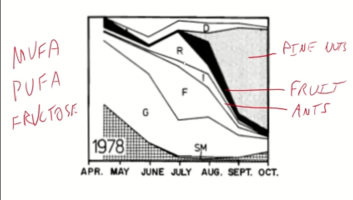youngsinatra
Member
The Emergence Diet : Get Out of Torpor! - Fire In A Bottle
In this video I ask how mammals get out of torpor. Grizzly bears are the most appropriate model organism: monogastric, large-bodied, omnivorous hibernators. We also happen to have very detailed knowledge about their diet and it may not be what you think. Before that, I look at the argument that...
 fireinabottle.net
fireinabottle.net
„
In this video I ask how mammals get out of torpor.
Grizzly bears are the most appropriate model organism: monogastric, large-bodied, omnivorous hibernators. We also happen to have very detailed knowledge about their diet and it may not be what you think.
Before that, I look at the argument that you really ARE in torpor, how you got there and ways to determine whether you are.
Signs that you might be IN torpor include low Vitamin B6, high kynurenine, high homocysteine, high nicotinamide and high 4-HNE (Ox-LDL).
Things hibernators use to get OUT of torpor (Emergence):
1) oxidants like succinate, alpha-ketoglutarate and pyruvate. These help inject oxygen so that you can burn fat.
2) Methyl groups in the form of SAMe. You could also use betaine, choline, methyl folate.
3) Dietary folate, B12, and polyphenols. All of these things help to limit Aryl Hydrocarbon Receptor activity.
4) Cholesterol excretagogues such as dandelions. You could use Pu-Ehr tea extract.
5) Bitter flavors such as dandelions. These activate bitter taste receptors and release GLP-1, the active ingredient in popular weight loss drugs like semaglutide.
Things hibernators use to get INTO torpor (Immergence):
1) Dietary MUFA. Often in the form of insects.
2) Dietary PUFA. Often in the form of nuts/acorns. The grizzly bears in Yellostone use pine nuts.
3) Dietary fructose. From fruit.
4) Lack of folate/B12/polyphenols.“
View: https://youtu.be/0f2xvn7lWao

